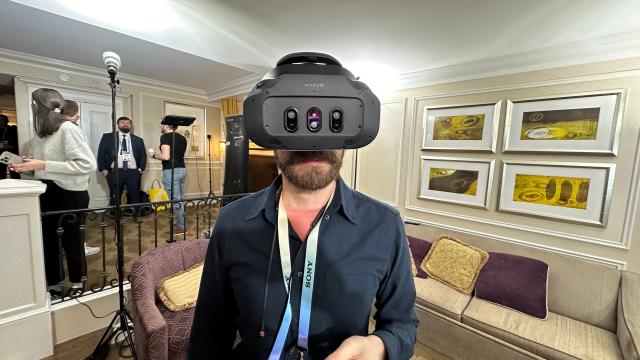There are some things about VR that remain as true today as they have for nearly the past decade, despite how much some companies want to rebrand the whole shebang. Varjo’s latest VR/AR headset, the $US3,990 XR4, wants to prove that solid displays, controls, and comfort remain the cornerstone of the VR space.
The headset is yet another enterprise-level device meant for the high-end enthusiast users and big businesses building workable VR apps, not so much the average Joe. I had the chance to jump into it anyway, not the least, because Apple has its own $US3,500 headset coming out in less than a month, and the next few months may prove just who has it right in these days of “spatial computing.”
Varjo revealed its latest headset last month, though Gizmodo finally had the chance to give it a spin at this year’s CES. My time with it was limited to a rather simple run through several high-fidelity environments filled with 3D environmental scans.
The company wasn’t promoting any particular software stack but was instead trying to showcase the headset’s visual fidelity. In that way, I felt like I was only seeing half of what the device was capable of, especially because I didn’t have the option to use Varjo’s hand tracking with the Ultraleap additional component.
I have not had the chance to use Apple’s Vision Pro, so I can’t compare how that system’s micro-OLED displays compare to Varjo’s latest headset. I can’t check how well the XR4’s passthrough or hand tracking compares to Apple’s first “spatial computer,” not least because Varjo’s headset uses a separate component for hand tracking. The company said that most of its users weren’t using the feature much, so they kept it separate from this latest release. Still, I couldn’t help but note it’s missing from my demo, which seemed deliberate.
But when you get past all that, the displays on the XR4 are some of the best in the VR industry. The device uses two 4K mini-LED displays for each eye running at a 90Hz refresh rate. They have 96% DCI-P3 coverage and up to 200 nits of brightness.
In my demo, the colors really popped with some pretty excellent contrast whether I was in some painter’s studio or hovering in space near a 3D model of the ISS. The device has a 120×105-degree field of view, which was only slightly limited once you turned on the passthrough feature, but Varjo did promise it plans to expand that FOV for the sake of seeing outside the headset in future updates.
I also tested how well the eye tracking worked in the XR4, and it was certainly impressive how well it could focus on what you were looking at while blurring the surroundings. There would certainly be applications that could make more interesting use of that eye tracking, but I didn’t see any of that in my demo.
The XR4 is also surprisingly comfortable. The headset itself is 1.46 pounds with a 0.8-pound strap. What helps is that it’s wired, so it does save some weight with the battery (the Vision Pro uses a separate battery pack that’s connected to the headset and stays in your pocket). It didn’t completely feel like I could forget there was a large hunk of plastic on my face, but it was very well balanced, and the mask didn’t grow warm or damp despite my using it for close to 30 minutes without pause.
Things are a little more murky with the XR4’s passthrough— literally. The latest headset uses two 20 MP cameras, which are a step up from the last version’s 12 MP cameras. Varjo told me there are many more sensors on the XR4’s shell, including LiDAR. Still, coming in and out of the VR into the AR, the virtual display had much higher fidelity than what was being picked up by the passthrough. The slightly limited FOV wasn’t too distracting, but the outside video was more washed out than reality was supposed to be. It’s easily a higher resolution than the passthrough on something like the Meta Quest 3, but color balance could still be used.
These ultra-expensive VR devices are pulling in different directions. You have the XR4 and the recently announced Sony-brand headset that lack any intrinsic software. On the other hand, Apple is stuffing the Vision Pro with apps from both iOS and iPadOS. It’s practically begging developers to make more apps for its headset, knowing that whoever actually buys one will expect it to work right out of the box. We won’t know how the Vision Pro really compares until later, but depending on sales, we could really see the lines blur between “enthusiast” and “layman” (at least for all those who somehow have more than $US3,000 to burn on a whim).
